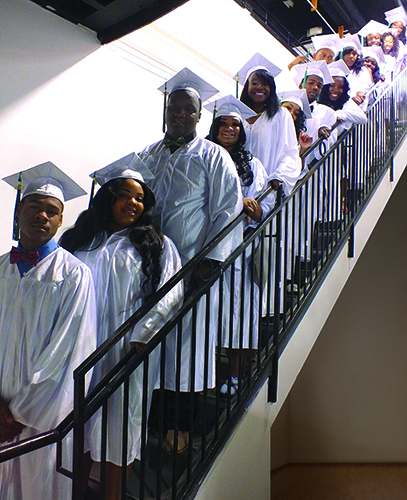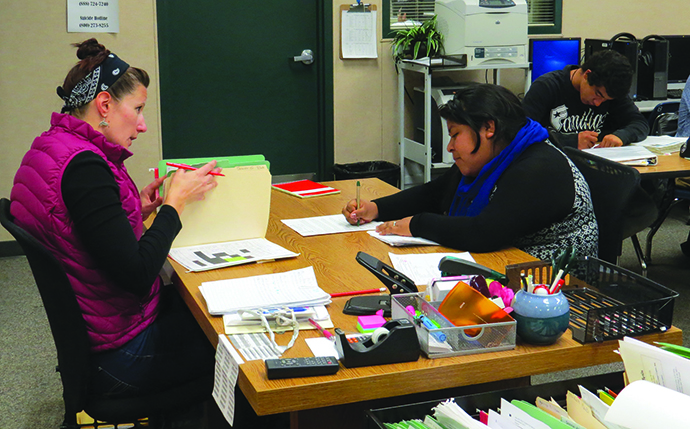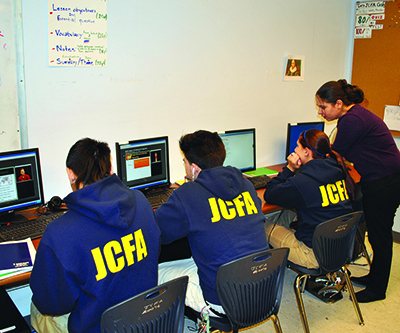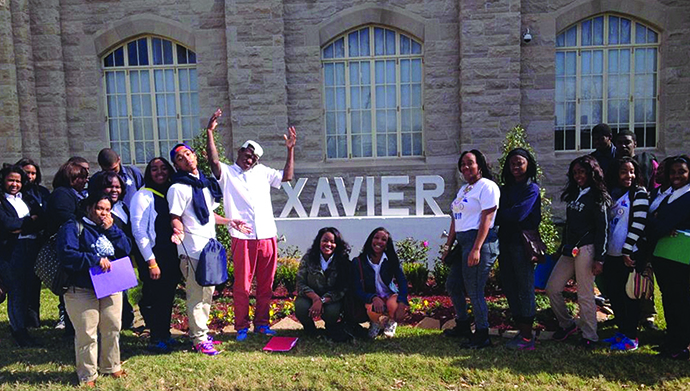New Orleans teenager Victoria McKnight bounced between three high schools before finding the right fit. One of the schools was too large and impersonal; the second closed long before McKnight had earned enough credits to graduate, so school officials encouraged her to transfer to the third school, NET Charter High School, which, as part of its curriculum, offers online classes to students who have fallen behind. Without the NET, McKnight, 18, doubts she would have ever earned a high school diploma; now she is on pace to do so in 2014.

(Photo/Shane Colman, Courtesy Net Charter High School)
McKnight says the computer-based courses allow her to work at her own speed and more easily avoid the distractions of classmates. But there are drawbacks, particularly when she is struggling to learn a new concept. “Some of the lessons I really don’t understand and some I do,” she says. “I would rather take it with a regular teacher because it would be more hands-on and you could ask questions.” The computer lab does have a full-time teacher, but students say it’s sometimes hard for him to respond to questions on a variety of subjects.
As online education grows in reach and sophistication, students like McKnight who are behind in credits are being pushed toward online credit-recovery programs. In communities including New Orleans, Los Angeles, and Chicago, educators are creating alternative schools for struggling students that employ online credit-recovery programs as a core portion, or all, of their curriculum. The most recent report from the National Center for Education Statistics (NCES) found that 55 percent of school districts reported using distance learning, most of it online, during the 2009–10 school year; more than 60 percent of those classes were taken for credit recovery. Meanwhile, about 80 percent of urban schools cite credit recovery as an issue of importance, according to the International Association for K–12 Online Learning.
NCES does not compile enrollment figures, but major online credit-recovery providers report surging enrollments. Arizona-based Edgenuity, for instance, serves about 1 million students annually, up 100 percent from two years ago. Although the company offers more than online credit recovery, a majority of its customers take its online courses for that purpose. Most companies selling online credit-recovery courses offer a host of online programs and classes, and few track what portion of their product is used for credit recovery. As a result, there are no concrete national data on how many students take online credit-recovery courses.
Even as online credit recovery hits the mainstream, for the most part it has remained free of any scrutiny beyond what individual school leaders and the consumer marketplace provide. Of course, the entire field of education, credit recovery or not, struggles with what makes a class or teacher good, great, or below par. In traditional education, however, there’s a nationwide war raging over accountability, with many states seeking ways to rate not only teachers and schools, but also teacher preparation and early childhood programs, based on quantifiable outcomes. With the exception of isolated pockets, like the Florida Virtual School (where funding of some online courses will soon be tied to passing an external exam), the conversation about accountability for online credit recovery has not been nearly as robust and far-reaching, in either a political or a pragmatic sense. Where there is nascent accountability for the quality of courses, it’s often a byproduct of the push for accountability in traditional education. Some states, for instance, are creating “end-of-course” exams aimed in part at assessing the efficacy of individual courses, whether traditional or online. But these are hardly universal and come nowhere close to covering the range and variety of courses offered by online providers. Edgenuity, for example, sells about 185 semester-length classes. “The field really struggles with the question of what makes a good or great online credit-recovery program,” explains Susan Patrick, president of the International Association for K–12 Online Learning.
Jessica Heppen, principal research analyst at the American Institutes for Research (AIR), is currently leading one of the only independent analyses of the effectiveness of online credit recovery courses. “There is a real dearth of research on credit recovery,” Heppen notes. “Even basic questions are unanswered, like the size of the business and the size of the need.” Because it’s limited to a single provider (Aventa/K12), a single course (Algebra I), and a single city (Chicago), the AIR study will not provide a broad sense of quality.
Counting Graduates
The growth in online learning generally, including blended learning, has fueled the proliferation of computer-based credit-recovery programs. The pressure on schools and educators to boost retention and graduation rates is a significant factor as well. Some argue that education leaders have their own reasons for not scrutinizing credit-recovery programs too closely. Such programs can be a lifeline, as schools can be punished or closed if they fail too many students and graduate too few. Schools and districts also stand to lose per-pupil funds when students drop out. If online courses can serve as an affordable means of keeping a student in school, there’s a financial incentive for embracing them. As a result, the push for greater accountability in K–12 education, including rating high schools based partly on graduation rates, might have the effect of suppressing the desire for accountability among online providers. “There’s a political motivation,” says David Bloomfield, professor of educational leadership, law, and policy at Brooklyn College. “It’s an end run around higher standards.”
Data about the credit-recovery industry are too incomplete, and change of all kinds too omnipresent in K–12 education, to posit a definite link between the spread of online courses and increased graduation rates nationally. But there’s evidence to suggest a connection in at least a few individual schools. The education news site GothamSchools (now Chalkbeat New York) reported on a guidance counselor at New York’s A. Philip Randolph High School, for example, who said she was instructed to enroll dozens of failing students in credit-recovery classes solely so they could earn their diplomas. Michael Bloomberg, who oversaw the schools as mayor from 2002 to 2013, has consistently denied that abuse of credit recovery led to rising graduation rates across the city during his tenure. Department of Education officials in New York City in January 2013 shored up the rules surrounding credit recovery in response to evidence that some schools were granting diplomas to students who had not met state or city graduation requirements. Students now have to take city-approved credit-recovery courses within a year of failing the traditional version and can only use that option to make up three core courses.
Patrick says there’s a “direct correlation” between the growth of online credit recovery and “the pressure school district administrators face in increasing graduation rates.” This pressure might not be a net negative if administrators use online credit recovery in creative and effective ways to meet the needs of students who have fallen through the cracks.
Larry Perondi, superintendent of the Oceanside Unified School District in California, reports that his district’s graduation rate has increased since the district opened three centers where struggling students can earn credits partly through online courses. But, more important, he believes the centers have improved the life prospects of students who would have dropped out otherwise, including young parents and teens battling drug addiction. To help keep the centers from becoming credit or diploma mills, Perondi encourages the district’s best teachers to work in them. Students can still participate in clubs and sports so they do not feel cut off from the rest of the school. And the district assigns extra counselors and social workers to the centers to ensure students have support when they need it.
While the district has not tracked how graduates of the centers perform compared to their peers on standardized tests and in college, Perondi feels confident that the district does enough to monitor quality. For the most part, the U.S. education system is relying solely on such vigilance and good intentions as online credit recovery grows.

(Photo/Courtesy of Oceanside Unified School District Communications Office, Steve Lombard)
Age-Old Questions
Credit recovery is not a new phenomenon: long before the advent of the Internet, many districts offered afterschool, summer school, or paper-and-pencil correspondence classes to students who needed to make up a failed course. These efforts have always had both proponents and detractors, whose long-standing debate speaks to a core tension and one that is mounting as credit-recovery opportunities expand: Is it better to graduate as many students as possible, even if many of their courses are subpar? Or is it better to ensure high standards for all, even if that prompts some of the marginal students to drop out?
The rapid rise of online education adds to the urgency of these questions, partly because it has fueled the spread of schools that specialize in helping dropouts to graduate. Some of the programs are fully online, while others employ a “blended” approach in which students spend part of their time in traditional classes or seminars. In the New Orleans area, three such schools, all of them charters, opened in the last five years. Each of them enrolls only students who have fallen behind in their academic coursework, and each uses online credit recovery for at least part of its curriculum. Not all of the students are “recovering credit” from a course they took and failed: some missed school because they were expelled, incarcerated, or temporarily gave up. The schools differ from the city’s other alternative programs because of their focus on online credit recovery and the fact that they do not exclusively enroll students who have gotten into trouble at other schools. Their supporters argue that the schools provide a much-needed safety valve for students who don’t work well in conventional settings and prefer to move through courses at their own pace; critics worry about the quality of the online courses and fear they take the onus off of traditional high schools to meet the needs of all students.
At the Jefferson Chamber Foundation Academy, most students are at least two years behind where they should be in academic credits; the average student is an 18-year-old sophomore. The two campuses are located in the New Orleans suburbs and enroll more than 200 teenagers. Some of the students failed the same classes multiple times; others dropped out for a period of months, or years. The school uses Edgenuity, formerly E2020, and spends about $50,000 per campus so that up to 200 users can take the company’s online courses at any given time. It supplements the online courses with in-person tutorials and small-group instruction. “Pretty much any course a student needs they can have access to,” says Millie Harris, the academy’s executive director. In a typical classroom, students sit wearing headphones in front of laptop computers, listening to videotaped lectures and presentations while one of their instructors circulates to make sure they are taking notes.
The NET, where McKnight enrolled two years ago, also uses Edgenuity credit-recovery classes, although its curriculum is only partially online; most students also take some traditional in-person classes and attend “advisory” courses where they research specific topics in depth. One fall morning, McKnight quietly progressed through an online environmental science class; she says it takes her about a semester to complete one of Edgenuity’s courses. A nearby student fumed after getting in trouble for trying to use her laptop to shop instead of study, but most of the students appeared occupied and content. McKnight watched an instructor give a videotaped lecture on “energy and resources” accompanied by PowerPoint-style notes. She said one of the course’s regular lecturers (all lectures are prerecorded) does not do a good job explaining what will be on the quiz that follows each lesson, so she was happy to see an instructor she liked on her computer screen that morning. After listening to the lecture through headphones, she dove into the quiz and answered multiple choice questions such as, “Which of the following is not considered an alternative form of energy?” McKnight scored 50 percent on her first attempt and notified the teacher in the room that she needed to retake the quiz. After glancing back through her notes, she netted a score of 70 percent (just barely passing) on a similar assessment. McKnight noted that sometimes the questions change, and other times she gets the same questions in a different order. She then moved on to the next lesson, on pollution and recycling.
Rigor Varies
Students and teachers say the online courses have some universal benefits: the teenagers can move at their own pace and get instant feedback on how they are doing. (A student sitting close to McKnight spent several minutes scrutinizing a pie chart showing, among other things, that he had completed 48 of 48 lessons on whole numbers and 20 of 46 on equations and fractions.) As a result, teachers can easily ascertain how much course material a student has mastered. Instead of trying to interpret a vacant expression on a student’s face, a teacher knows immediately to check in with a student who has been “idle” for more than a few minutes online. Students who spent their time joking and goofing off in traditional classes do not have an obvious “stage” in a room where most of their classmates are wearing headphones and focused on individual computers.
The biggest drawback, however, is that many of the courses are either too easy or too hard. And while a good “live” teacher can adjust her instruction based on student need, that’s not so easy with a pre-scripted online course. Indeed, stronger schools and teachers are increasingly figuring out how to use the online courses as a jumping-off point to address individual students’ needs, supplementing easy courses with more challenging material, for instance, or harder courses with extra in-person tutorials. But the weaker programs do little to address these issues, relying solely on the online content. As online education spreads, this gap in implementation could become more meaningful than the gaps in course quality (particularly since well-run programs are also more likely to purchase higher-quality online courses from the start).

(Photo/Courtesy of Jefferson Chamber Foundation Academy)
Vasy McCoy, head of ReNEW Accelerated High School in New Orleans, says he stopped using the online course provider Plato because the online courses weren’t engaging enough, and when students failed quizzes they sometimes retook ones that were too similar to the original version. Twenty-year-old Lawrencia McCarty, who lives in New Orleans, says one online credit-recovery course in world history required next-to-no critical thinking. McCarty failed the traditional version of world history when she took it at the city’s Sophie B. Wright Charter School. But when she took the online course, the lecturers usually told her verbatim what would be on the quizzes, and she could retake them as many times as she needed to earn a passing grade. Sometimes the questions changed, while other times they didn’t. “Online was much easier,” she says. “But you learn more in a regular class.”
Partly for this reason, the National Collegiate Athletic Association (NCAA) started policing the online education industry. Annually, thousands of high school athletes submit applications for eligibility on college teams, and the NCAA duly reviews their transcripts to make sure enough of their courses measure up to the organization’s standards. Every day, NCAA staff review upward of 400 new courses: A school might shift the title of a class from British Literature to Shakespearean Literature, for instance, or add a series of International Baccalaureate classes to their list.
About six years ago, the NCAA noticed a surge in the number of online credit-recovery courses (although not all were labeled as such on student transcripts), says Nicholas Sproull, whose department oversees the course review efforts. Some took only days—or hours—for students to complete (in one particularly egregious case, a student received an algebra credit after being logged in to the course for less than two minutes, says Sproull). Others allowed students to retake the same multiple-choice test again and again until they passed. But few in the education community appeared to be paying attention.
So the NCAA devised its own system for guarding against abuses. In the case of online credit-recovery classes, Sproull’s staff attempts to gauge whether they entail a significant investment of time, require frequent and meaningful interaction with an instructor, and are part of a college preparatory curriculum. The “vast majority” of the online credit recovery courses the NCAA reviews fail to meet at least one of those standards and thus don’t count toward a student’s athletic eligibility, says Sproull. “When kids are just clicking their way through courses, that’s generally not a college prep experience,” he adds.
Aiming Too High
There’s also evidence that some online credit-recovery courses can be significantly harder than their face-to-face counterparts. The early results of Heppen’s study for AIR at 15 high schools in Chicago suggest that can be the case. A significantly higher percentage of students in the traditionally structured algebra credit-recovery classes earned a grade of C or higher (44 percent) than in the online classes (about 30 percent). Moreover, students in the online courses rated their classes as more difficult than students in the face-to-face ones.
By definition, students taking online credit-recovery classes are behind in school. At programs like the NET and ReNEW Accelerated, students typically read and do math a few grade levels below where they should be. One of the Jefferson Chamber Foundation Academy campuses admits only students at or above a 6th-grade reading level because teachers worry that otherwise they won’t be able to handle the online classes; at the other campus, students reading at the 2nd- or 3rd-grade level sometimes struggle with the coursework, says Harris. “The difficulty is that [the online courses] are at the high school level, but not all of the kids are at the high school level,” says Elizabeth Ostberg, principal at the NET. “There are very few kids that we can plug into the computer and have them take this class. There’s a reason they dropped out of school.”
As a result, the staff and teachers at schools like the NET and ReNEW Accelerated end up working extensively with the students on note-taking skills, supplementing the credit-recovery classes with more personalized instruction, and prepping the students for the content they will encounter online. “We preload information,” says McCoy. For instance, most of ReNEW’s students struggled to grasp the meaning of “tone” based solely on an online English course’s rote repetition of the definition. So one of the teachers gave a lesson on tone before students even started the online course to ease them into the concept more gradually and with better examples. Leaders of schools that rely heavily on online credit recovery say they try to purchase courses that can be easily broken apart, so teachers can reorder the lessons or pull out specific sections to meet individual students’ needs. ReNEW Accelerated switched to CompassLearning Odyssey courses because the quizzes were tougher, but also because teachers could make changes to the material more easily and the lessons are presented in a much more engaging way on the computer screen.

High-Tech Textbooks
Since there’s growing competition in the online course market, companies are under pressure to make quick changes and improvements to meet client demand. But as the experience at ReNEW underscores, even the most malleable, well-designed, and interactive online course can fail to compensate for the presence of a strong teacher who knows which students need an extra lesson or might need to repeat a unit in order to master the material. “The online curriculum doesn’t work in and of itself,” confirms McCoy. “You have to have small-group instruction.” Schools like ReNEW and the Jefferson Chamber Foundation Academy spend far more money on teachers and staff than they do on online software: software and licenses for 100 students cost about the same as one teacher’s salary.
With so little known about the efficacy of online credit-recovery courses, teachers and other onsite staff are in the best position to gauge quality and intervene when necessary. Eighteen-year-old Cedrecka Jones likes the mixture of online and face-to-face classes she gets as a student at the NET and doesn’t feel as if the difficulty between the two varies tremendously. But she gets frustrated in the computer lab at times since she can’t ask questions of the online lecturers. “I ask a lot of questions, especially when I don’t understand something,” she says. Online, “a company teaches you, and they don’t teach as fully as a real teacher would.”
Although Jones does have access to a teacher in the computer lab, her comment points to a broader truth when it comes to online learning: Schools and districts, particularly those hoping to use online credit recovery to help catch up students who have fallen behind, would be wise to see the new courses as elaborate, high-tech textbooks: highly variable in their quality, in need of substantial vetting, and—except for the rare student—utterly insufficient on their own.
Sarah Carr is senior editor at the Hechinger Report and author of Hope Against Hope, which tells the story of New Orleans schools after Hurricane Katrina.
This article appeared in the Summer 2014 issue of Education Next. Suggested citation format:
Carr, S. (2014). Credit Recovery Hits the Mainstream: Accountability lags for online options. Education Next, 14(3), 30-36.


